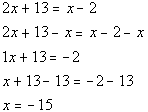

![]()

![]()
![]()

*Inverse of sub. 7.1 is add 7.1
![]()
Using the distributive property and then combining like terms to simplify
the left side of the equation we get:


*Inverse of add 13 is sub. 13
Two numbers have a sum of 200. If one number is x,
express the other number in terms of x.
So, 200 - x is our answer.
Last revised on July 26, 2011 by Kim Seward.
All contents copyright (C) 2001 - 2011, WTAMU and Kim Seward.
All rights reserved.